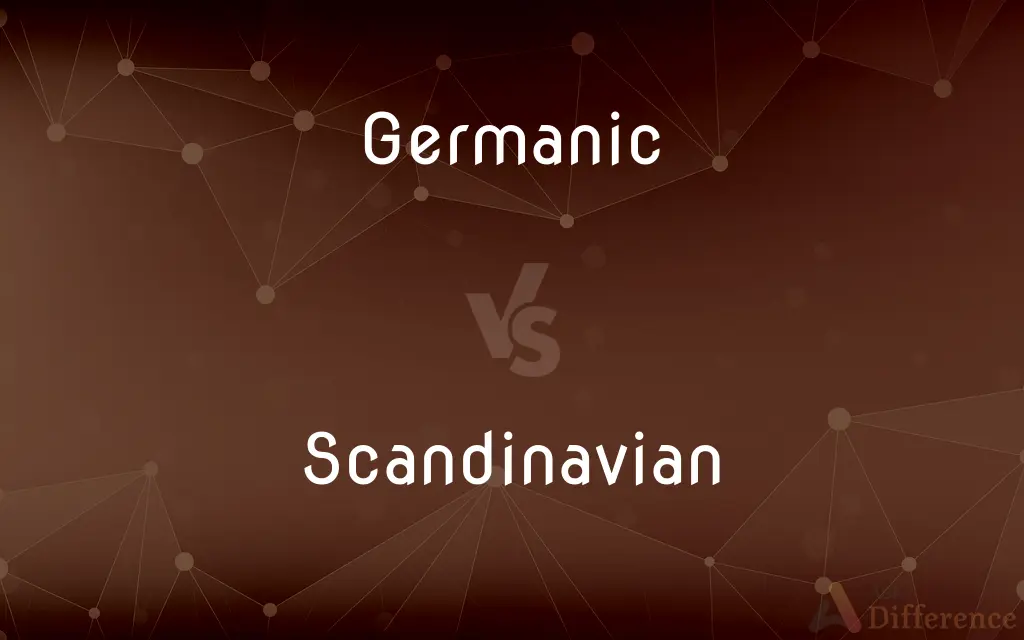Germanic vs. Scandinavian — What's the Difference?
Edited by Tayyaba Rehman — By Urooj Arif — Updated on April 15, 2024
Germanic refers to the broader group of Indo-European languages and peoples, including Germans and Scandinavians, while Scandinavian specifically denotes languages and cultures from Norway, Sweden, and Denmark.

Difference Between Germanic and Scandinavian
Table of Contents
ADVERTISEMENT
Key Differences
Germanic encompasses a large family of languages and cultures in Europe, characterized by its historical spread and influence, from English to German. Whereas, Scandinavian is a subset of this group, focused specifically on the languages and cultures of the Nordic countries such as Norway, Sweden, and Denmark.
The Germanic group includes ancient tribes known for their migration and settlement across Europe, leading to diverse linguistic and cultural developments. On the other hand, Scandinavian tribes, known as Norse or Vikings, were particularly noted for their seafaring, exploration, and unique cultural traits like Norse mythology.
Linguistically, Germanic languages are divided into three branches: West, East, and North Germanic. Scandinavian languages form part of the North Germanic branch, sharing closer linguistic ties and mutual intelligibility.
In terms of geography, Germanic regions cover a broader area including Germany, Austria, and parts of the Netherlands and Switzerland. Conversely, Scandinavian countries are geographically confined to the northern part of Europe, comprising Norway, Sweden, and Denmark.
Cultural practices within the Germanic regions vary widely from Oktoberfest in Germany to the Dutch Sinterklaas. Scandinavian culture, however, is often associated with specific traditions such as the Midsummer celebration and a strong emphasis on social welfare and egalitarianism.
ADVERTISEMENT
Comparison Chart
Geographic Scope
Broad (Europe-wide)
Narrow (Northern Europe)
Languages Included
English, German, Dutch, etc.
Norwegian, Swedish, Danish
Historical Tribes
Various including Goths, Vandals
Primarily Norse or Vikings
Cultural Highlights
Diverse (e.g., Oktoberfest, Dutch art)
More uniform (e.g., Midsummer, saunas)
Modern Countries
Germany, Netherlands, England, etc.
Norway, Sweden, Denmark
Compare with Definitions
Germanic
Involving nations primarily speaking Germanic languages.
Germanic influences are evident in modern European culture.
Scandinavian
Characteristic of social welfare models found in Nordic countries.
Scandinavian countries are often cited as examples of successful welfare states.
Germanic
A branch of the Indo-European language family.
Germanic languages include English, German, and Dutch.
Scandinavian
Of or pertaining to the North Germanic branch of languages.
Scandinavian languages are known for their melodic sound and pitch accent.
Germanic
Pertaining to the peoples, languages, or cultures originally coming from northern Europe.
The Germanic tribes once dominated a large part of Europe.
Scandinavian
Involving the historical context of Vikings and Norse exploration.
Scandinavian history is rich with tales of Viking explorers.
Germanic
Relating to characteristics associated with Germanic peoples, like robustness and efficiency.
The engineering project was approached with a Germanic sense of precision.
Scandinavian
Relating to Norway, Sweden, and Denmark, especially concerning cultural or linguistic characteristics.
Scandinavian design emphasizes minimalism and functionality.
Germanic
Linked historically to ancient tribes known for their migration across Europe.
The influence of Germanic laws can be seen in many European legal systems today.
Scandinavian
Reflecting traditions and celebrations unique to the Nordic region.
The celebration of Midsummer is a key aspect of Scandinavian culture.
Germanic
Of, relating to, or characteristic of Germany or its people, language, or culture.
Scandinavian
Of or relating to Scandinavia or to its peoples, languages, or cultures.
Germanic
Of or relating to the Teutons.
Scandinavian
A native or inhabitant of Scandinavia.
Germanic
Of or relating to the branch of the Indo-European language family that comprises North Germanic, West Germanic, and the extinct East Germanic.
Scandinavian
A person of Scandinavian ancestry.
Germanic
Of or relating to a member of a Germanic-speaking people.
Scandinavian
See North Germanic.
Germanic
The Germanic branch of Indo-European.
Scandinavian
Of or pertaining to Scandinavia, that is, Sweden, Norway, and Denmark.
Germanic
Of or containing germanium.
Scandinavian
An inhabitant of Scandinavia
Germanic
Containing germanium with a valence of 4.
Scandinavian
The northern family of Germanic languages that are spoken in Scandinavia and Iceland
Germanic
Pertaining to, or containing, germanium.
Scandinavian
Of or relating to Scandinavia or its peoples or cultures;
Norse sagas
Norse nomads
Germanic
Of or pertaining to Germany; as, the Germanic confederacy.
Germanic
Teutonic.
Germanic
A branch of the Indo-European family of languages; members that are spoken currently fall into two major groups: Scandinavian and West Germanic
Germanic
Of or relating to the language of Germans;
The Germanic sound shifts
Germanic
Of or pertaining to the ancient Teutons or their languages;
Teutonic peoples such as Germans and Scandinavians and British
Germanic mythology
Germanic
Of a more or less German nature; somewhat German;
Germanic peoples
His Germanic nature
Formidable volumes Teutonic in their thoroughness
Common Curiosities
How do Scandinavian countries reflect their Germanic roots?
While maintaining unique identities, Scandinavian countries reflect their Germanic roots through language, certain cultural practices, and historical narratives.
What historical impact did Germanic tribes have on Europe?
Germanic tribes played a crucial role in the formation of modern European nations through their migrations and settlements.
How are Scandinavian languages classified within the Germanic family?
Scandinavian languages are classified as North Germanic, sharing closer ties with each other than with other Germanic languages.
What role does mythology play in Scandinavian culture?
Norse mythology plays a significant role, influencing everything from literature to popular media.
Can you compare the Viking Age to other Germanic eras?
The Viking Age is distinct for its maritime explorations and raids, unlike other Germanic eras focused more on continental expansion and settlement.
What defines Germanic culture?
Germanic culture is defined by its historical spread across Europe, encompassing a wide range of languages, traditions, and national identities.
How is the term 'Germanic' used in academic contexts?
In academics, 'Germanic' refers to studies of languages, history, and archeology related to the ancient and modern Germanic-speaking peoples.
What languages are spoken in Germanic countries outside of Scandinavia?
Languages include German, English, Dutch, and several others, reflecting the broad spread of the Germanic linguistic family.
What are some common cultural practices in Scandinavian countries?
Common practices include Midsummer celebrations, extensive social welfare systems, and a strong emphasis on education and egalitarianism.
Are all Germanic languages mutually intelligible?
Not all; while some have high degrees of mutual intelligibility, especially within subgroups like Scandinavian, others, like English and German, do not.
What distinguishes Scandinavian social policies?
Scandinavian social policies are distinguished by their focus on comprehensive welfare benefits and an inclusive approach to governance.
What are the main differences in traditional celebrations between Germanic and Scandinavian cultures?
Traditional celebrations in Germanic cultures vary widely, while Scandinavian ones often revolve around seasonal changes and historical events.
Share Your Discovery

Previous Comparison
Telnet vs. SSH
Next Comparison
Wari vs. MancalaAuthor Spotlight
Written by
Urooj ArifUrooj is a skilled content writer at Ask Difference, known for her exceptional ability to simplify complex topics into engaging and informative content. With a passion for research and a flair for clear, concise writing, she consistently delivers articles that resonate with our diverse audience.
Edited by
Tayyaba RehmanTayyaba Rehman is a distinguished writer, currently serving as a primary contributor to askdifference.com. As a researcher in semantics and etymology, Tayyaba's passion for the complexity of languages and their distinctions has found a perfect home on the platform. Tayyaba delves into the intricacies of language, distinguishing between commonly confused words and phrases, thereby providing clarity for readers worldwide.














































